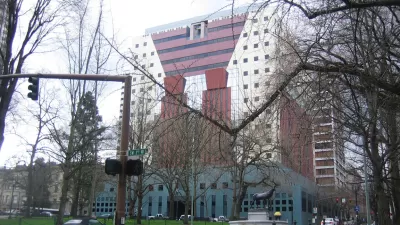Blair Kamin takes an appreciative view of Michael Graves' Humana Building, now a defining icon of Derby City, and the much derided postmodern architecture movement.
The 20th century was as dizzying a time for the world of architecture as it was for any other art form – never before in history could buildings become so outdated in such a short span of time. As a movement, postmodernism is notable for the way it has fallen out of favor, criticized "for producing a pastiche of historical references," as Kamin puts it - "a column tacked on here, a pediment there."
But to truly appreciate the merits of postmodern architecture and separate the wheat from the chaff, it is important to understand its historical context of "the early 1980s, when postmodernism was at the height of its influence and architects were in full revolt against the abstract forms of commercial modernism." Michael Graves' Humana Building is one of those buildings that successfully balanced that revolt against the aesthetic sensibilities of the surrounding city.
In 1982, Graves won his second major international design competition for a 27-story office complex to house a large hospital company (now a Fortune 100 health insurance provider). "Architectural models of the five [finalists'] designs are still displayed in the Humana complex, and they reveal how Graves crafted a tower that could only have been built in Louisville" – a reflection of his "contextual" architectural philosophy.
For its grand frontage, various tributes to the Ohio River, and unique approach to office space, the Humana Building makes room for redemption in the legacy of postmodernism.
FULL STORY: A postmodern gem, reconsidered

Maui's Vacation Rental Debate Turns Ugly
Verbal attacks, misinformation campaigns and fistfights plague a high-stakes debate to convert thousands of vacation rentals into long-term housing.

Planetizen Federal Action Tracker
A weekly monitor of how Trump’s orders and actions are impacting planners and planning in America.

In Urban Planning, AI Prompting Could be the New Design Thinking
Creativity has long been key to great urban design. What if we see AI as our new creative partner?

King County Supportive Housing Program Offers Hope for Unhoused Residents
The county is taking a ‘Housing First’ approach that prioritizes getting people into housing, then offering wraparound supportive services.

Researchers Use AI to Get Clearer Picture of US Housing
Analysts are using artificial intelligence to supercharge their research by allowing them to comb through data faster. Though these AI tools can be error prone, they save time and housing researchers are optimistic about the future.

Making Shared Micromobility More Inclusive
Cities and shared mobility system operators can do more to include people with disabilities in planning and operations, per a new report.
Urban Design for Planners 1: Software Tools
This six-course series explores essential urban design concepts using open source software and equips planners with the tools they need to participate fully in the urban design process.
Planning for Universal Design
Learn the tools for implementing Universal Design in planning regulations.
planning NEXT
Appalachian Highlands Housing Partners
Mpact (founded as Rail~Volution)
City of Camden Redevelopment Agency
City of Astoria
City of Portland
City of Laramie




























